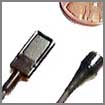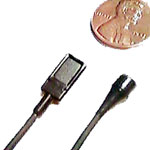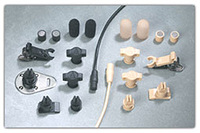 Originally, the term "lavalier" referred only to the "neck-worn" or "body-worn" class of small microphones. These days, the working definition of lavalier has been extended to include virtually any miniature microphone small enough to be worn on the body and/or hidden in the set.
Originally, the term "lavalier" referred only to the "neck-worn" or "body-worn" class of small microphones. These days, the working definition of lavalier has been extended to include virtually any miniature microphone small enough to be worn on the body and/or hidden in the set.
A brief history
The first lavaliers used by our industry were large, dynamic microphones about the size of a cigar tube. These mics were traditionally worn around the neck by means of a lanyard (lavaliere). The mics were very rugged, but had a very short pick-up range and had to worn close to the mouth. Because of their relative insensitivity to sound, they were very feedback resistant. Units manufactured by Sennheiser and ElectroVoice were very popular in their time; many can still be found at garage sales, priced to go at almost free.
By the way, it is worth noting that the author still keeps a vintage ElectroVoice 649B dynamic lavalier in his sound kit for use as a slate mic or as an "expendable" sound effects mic.
 The technology of the sixties saw a miniaturization of the lavalier. The Sony ECM-50 became the broadcast standard. The ECM-50 was an electret condenser, omni lavalier. Compared to the older dynamic lavs, the ECM-50 was considered miniature, even though it was almost one inch long by half an inch in diameter. The ECM-50 was far more sensitive, and its greater bass response complimented the golden throated newscasters of the era.
The technology of the sixties saw a miniaturization of the lavalier. The Sony ECM-50 became the broadcast standard. The ECM-50 was an electret condenser, omni lavalier. Compared to the older dynamic lavs, the ECM-50 was considered miniature, even though it was almost one inch long by half an inch in diameter. The ECM-50 was far more sensitive, and its greater bass response complimented the golden throated newscasters of the era.
Years later, Sony introduced the ECM-30, a smaller and less expensive version of the ECM-50. Film and video people took a liking to it immediately. The ECM-30 was much smaller and easier to hide. More importantly, the mic lacked the extended bass response of the ECM-50, which translated into less wind noise and rumble when used outside of a studio.
(Sony evolved the ECM30 into the ECM44; and the ECM50 became the ECM55.)
Of course, over the years, other manufacturers entered the marketplace with lavaliers of their own. Witness the ElectroVoice CO-90, the TRAM TR-50, the MiniMic, the Sennheiser MKE-2, and others.
Which brings us up to the present.
Modern lavaliers can be described as being either "Proximity" or "Transparent".
A Proximity type lavalier is defined as a microphone that works best when kept fairly close to the source of the voice, emphasizes that voice, and suppresses background.
A prime example of this sort of lavalier is the Sony ECM-55 (the current successor to the ECM-50).
Proximity lavaliers produce the "lavalier perspective"; emphasis of the voice in a "tight close-up" sort of way. You know -- the newscaster, stand-up reporter, on-camera narrator, radio interview, voice of authority kind of sound.
Proximity lavaliers are the best way to go if you desire an authoritative sound with minimal background noise. They are also the mic of choice if there is simultaneous sound reinforcement (public address), since they are not as prone to cause feedback as other more sensitive mics.
Transparent lavaliers are defined as sounding more like omnidirectional recording studio mics. They are very sensitive to sounds, and their volume vs. distance characteristics are far more gradual than that of proximity lavaliers. Transparent mics can be deployed at greater distances; and are far more forgiving of talent turning their heads away from the mic.
Transparent mics sound much more natural and less forced than proximity mics. Used on a video set, these mics will intercut much easier with overhead boom mics.
The drawback to transparent mics is that they are much more sensitive to background noise, and also require greater skill to hide under clothing.
Lavaliers can also be classified as omni-directional or uni-directional (cardioid). For use in production, I prefer omni-directional over cardioid. Omni lavs are not affected by shifts in clothing angle or body angle, which are common events when we hide them under wardrobe during theatrical filmmaking. Clothing can shift around slightly as the actor moves aggressively. If the mic were directional, it might suddenly be aimed 15 or 20 degrees away from the mouth.
Also, an omni pattern means that we do not have to concern ourselves with the angle of the mic capsule when we rig it, thus giving us more creative freedom to hide mics in places where it does not aim towards the mouth, such as on the side rim of eyeglasses or the under brim of a hat.
Cardioid pattern lavaliers, on the other hand, need to be carefully positioned so that they point to the mouth. This is easy to achieve if we are using a tie clip mount in the chest area, center shirt or center lapel. Rigging a stoic lecturer or preacher in this manner would not be a problem; and the fact that the mic is directional would help prevent acoustic feedback from a live sound system.
Cardioid lavaliers can be useful at times as hidden plant mics, if you are able to effectively position the mic so that it aims toward the actor like a miniature shotgun mic.
As mentioned before, the Sony ECM-55 is a longtime standard of the industry and is a proximity type lavalier. It is cylindrical in shape, measuring roughly 1/2" in diameter by 1" long. This mic has a pronounced bass response, and is excellent for audio interviews, narration, and public address. It is not as useful a mic to use outside of the studio, due to its sensitivity to wind and rumble. This mic is not very forgiving of off-axis voice; when talent turns their head away the sound level drops off considerably.
On the border between proximity and transparent is the Sony ECM-44. The ECM-44 is probably the most popular all-purpose lavalier on the market. It is more open sounding than the ECM-50, but still does a good job of suppressing background. It is somewhat forgiving of head turns. The mic exhibits a slight warmth in the middle frequency range, which promotes the clarity of voice over background. Also, the ECM-44 does not have the bass sensitivity of the ECM-55, making this a better sounding microphone to use in the field.
Very similar in sound quality, but less expensive, is the Audio Technica AT803. The AT803, when its low cut setting is selected, emulates the “natural” sound of the Sony ECM44; but if you select the flat response setting, the AT803 has the fuller sound of the ECM55.
 Moving towards the transparent group of lavaliers, we come to the TRAM TR-50. This very tiny microphone differs from the Sony’s in that it has a front facing grill. The Sony’s have their openings on the top.
Moving towards the transparent group of lavaliers, we come to the TRAM TR-50. This very tiny microphone differs from the Sony’s in that it has a front facing grill. The Sony’s have their openings on the top.
Remember, all of these lavaliers are omnidirectional, so it does not matter which way the mics or their grills are oriented. Just pay attention when you are rigging them so that you don’t accidentally block up or tape over the hole.
TRAMs are famous for their wide array of mounting clips and tricks. In addition to the traditional tie bars, TRAM also offers "vampire clips" (not TRAM's designation, but a nickname that has caught on), boundary plate style plastic mounts, leather tapedowns, and a host of goodies.
The sound of the TRAM TR-50 is very good. It is more transparent and natural sounding than the ECM-44, but not quite as open as some of the other transparent mics.
Countryman and Voice Technologies make some interesting lavaliers. The Countryman mics are offered in a flat faced configuration (EMW) as well as a miniature round top (B3). (Shown to the right) Countryman  also makes a super miniature round top not much thicker than a spaghetti noodle (B6). Voice Technologies offers a flat faced configuration. What makes both of these brands interesting is that they are proximity mics (short range, strong rejection of background) but with a very natural sound. Originally created for Broadway shows, these mics are useful to filmmakers who need to mike actors within a noisy environment. But they are not good as plant mics.
also makes a super miniature round top not much thicker than a spaghetti noodle (B6). Voice Technologies offers a flat faced configuration. What makes both of these brands interesting is that they are proximity mics (short range, strong rejection of background) but with a very natural sound. Originally created for Broadway shows, these mics are useful to filmmakers who need to mike actors within a noisy environment. But they are not good as plant mics.
 My favorite transparent lavaliers to use are the Audio Technica AT899 & MT830, Sennheiser MKE-2, and the Sony ECM-77. All of these lavaliers are extremely sensitive, and work very well as plant mics or body mics. They sound very natural, and intercut perfectly with overhead boom mics. They make excellent plant mics hidden in sets. They also allow the pickup of other persons near the actor wearing them; very handy in a documentary or covert situation.
My favorite transparent lavaliers to use are the Audio Technica AT899 & MT830, Sennheiser MKE-2, and the Sony ECM-77. All of these lavaliers are extremely sensitive, and work very well as plant mics or body mics. They sound very natural, and intercut perfectly with overhead boom mics. They make excellent plant mics hidden in sets. They also allow the pickup of other persons near the actor wearing them; very handy in a documentary or covert situation.
Their drawback, however, is their sensitivity: sometimes they can hear too much background. They also require more care in rigging under clothing. But they do sound great!
